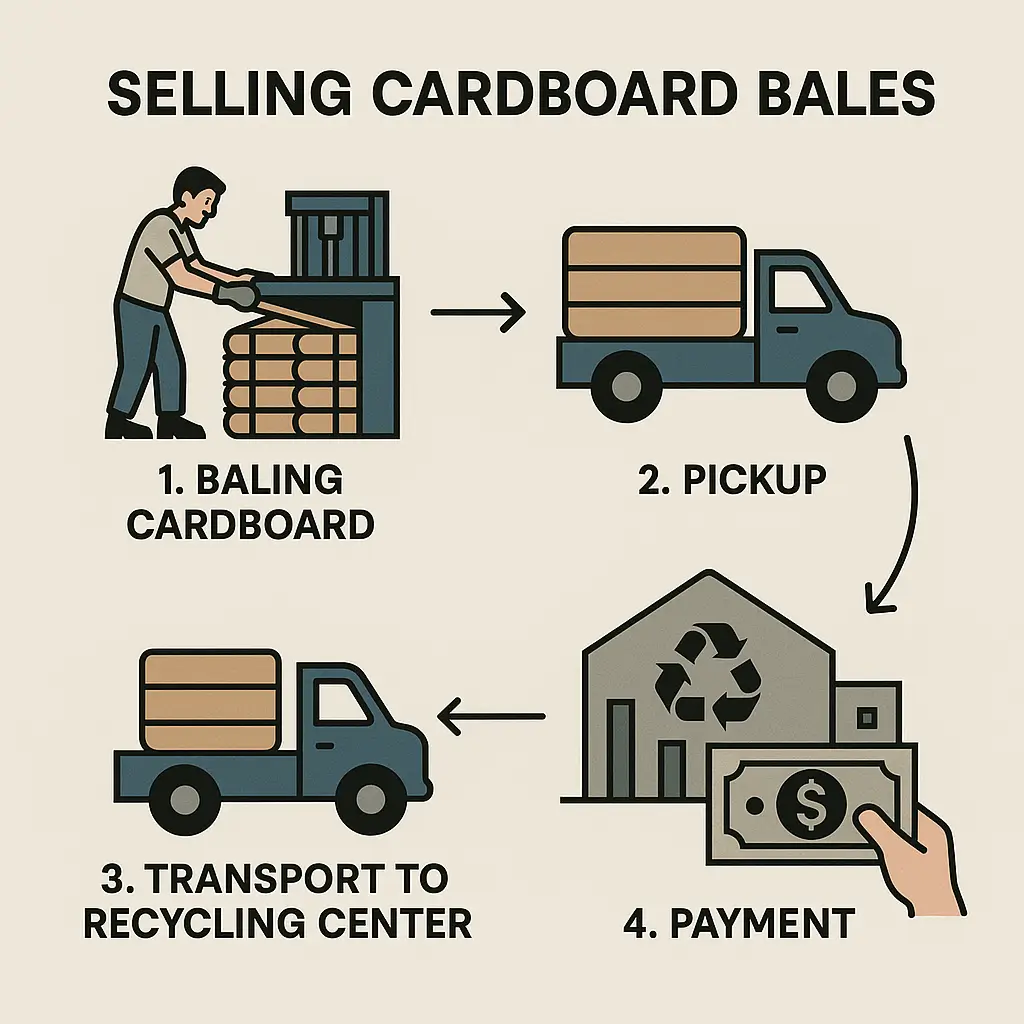Key Takeaway: The most lucrative and convenient options for selling or recycling cardboard bales include local scrap yards and recycling centers, industrial paper mills, national brokers and consolidators, and specialized waste-hauling companies. Many of these buyers offer on-site pickup and pay competitive rates, often on a per-ton or per-pound basis. Building a reliable relationship with a consistent buyer will streamline logistics, maximize revenue, and ensure environmentally responsible processing of your cardboard bales.
1. Overview of the Cardboard Bale Market
Cardboard bales—bundled and compressed corrugated cardboard—are a high-value commodity in the recycling industry. Because corrugated fiberboard represents a substantial portion of municipal and commercial waste streams, paper mills and recyclers depend on a steady supply of baled cardboard to maintain production of recycled paperboard and containerboard. Key factors affecting bale pricing:
- Fiber Quality: Clean, dry, uncontaminated corrugated cardboard fetches higher prices.
- Bale Weight and Density: Heavier, tightly compressed bales lower transportation costs per ton, often yielding better payouts.
- Regional Demand: Proximity to paper mills or consolidators reduces hauling fees and can raise net revenue.
- Global Market Fluctuations: International export demand for OCC (old corrugated containers) influences domestic scrap prices.
2. Primary Buyers of Cardboard Bales
| Buyer Type | Description |
|---|---|
| Local Scrap Yards & Recycling Centers | Typically accept loose and baled cardboard; pay by weight. Rates vary but are often updated weekly. On-site scales enable immediate payment. Some centers only accept baled material. |
| Industrial Paper Mills | Significant buyers of large volumes; require consistent supply contracts. They may handle logistics directly or through regional brokers, and prices are often negotiated quarterly. |
| National Brokers & Consolidators | Networked companies that aggregate from multiple sellers, offering pickup services and consistent pricing. They resell to mills or exporters. Good option for small to midsize generators lacking direct mill contracts. |
| Waste Haulers & Sustainability Firms | Offer curbside or behind-the-dock pickup, charge a service fee, and credit account holders for net bale value (bale value minus hauling fee). Ideal for businesses generating moderate bale volumes. |
| Exporters | Companies that package and ship OCC overseas. Often require minimum quantities and tightly packed bales. Pricing may differ from domestic mill pricing due to export tariffs and shipping costs. |
3. Where to Sell Cardboard Bales Near You
3.1 Local Scrap Yards and Recycling Centers
Search “scrap yard near me” or “recycling center cardboard” to find facilities that purchase bales by the ton. Many family-owned yards specialize in paper grades.
- Service Features:
- Walk-in drop-off
- On-site scale and same-day payment
- Lower minimum volumes than mills
- Examples of Nationwide Chains:
- Schnitzer Steel (in select states)
- Sims Municipal Recycling
- Metalico (often co-locates with paper divisions)
3.2 Industrial Paper Mills
Direct sales to paper mills yield the best prices but usually require bale volumes of 50+ tons per month.
- How to Approach Mills:
- Identify regional mills producing linerboard or corrugated medium.
- Request a quote and inquire about bale specifications (e.g., 800–1,200 lb bales strapped with steel or polypropylene bands).
- Negotiate contractual terms, including delivery schedules and quality tolerances.
3.3 National Brokers and Aggregators
If you have 5–50 tons monthly, brokers consolidate loads from multiple sources and arrange transport. They may handle quality control and grading on your behalf.
- Benefits: Lower logistical complexity, regular pickups, expertise in grade sorting.
- Examples:
- S.P. Richards (paper redistribution)
- Sunshine Paper Company
- Continental Recycling
3.4 Waste Haulers and Sustainability Service Providers
Many roll-off and front-load waste companies offer cardboard bale pick-up. They bundle hauling service with commodity credit.
- Typical Model: Monthly invoice credits for bale weight (e.g., $50/ton credit minus hauling fee).
- Providers:
- Waste Management
- Republic Services
- GFL Environmental
3.5 Exporters
For large, tightly baled volumes, export markets (Asia, Middle East) often pay premiums for high-grade OCC. However, shipping costs and export duties can offset gains. Export buyers generally require:
- Minimum order size (20–40 tons)
- Consistent fiber quality (clean, dry, free of waxed or wet-strength liners)
4. Logistics: Pickup, Drop-Off, and Preparation
4.1 Preparing Cardboard Bales
- Cleaning: Remove contaminants—plastic, foam, metal staples.
- Drying: Bales must be free of moisture to avoid mold and weight penalties.
- Strapping: Use steel or polypropylene bands. Tighter bales reduce trailer dead-space charges.
- Weight Consistency: Aim for 800–1,200 lbs per bale.
4.2 Drop-Off vs. On-Site Pickup
- Drop-Off: Lower cost but requires loading and transport arrangements. Ideal for small-scale or infrequent sellers.
- Pickup Services: Paid or credit-based; convenient for businesses lacking transport assets.
- Roll-Off Container Rental: When bale volumes exceed 30 tons/month, a dedicated roll-off compactor may pay back via compaction and transport savings.
4.3 Scheduling and Frequency
- Weekly/Biweekly Pickup: Maintains lean inventory; avoids storage space overrun.
- On-Demand Requests: For sporadic surpluses; typically incurs minimum service charges (e.g., $150/trip).
5. Pricing Dynamics and Payment Methods
| Pricing Factor | Impact on Revenue |
|---|---|
| Bale Quality | Premium for pure corrugated; discount for mixed-grade or contaminants |
| Regional Demand | Higher prices near mills; depressed in oversupplied regions |
| Seasonal Fluctuations | Export demand spikes in fourth quarter; domestic demand steadier year-round |
| Transportation Distance | Net price = mill/broker price – haul cost; shorter routes maximize net proceeds |
| Contract vs. Spot Sales | Contract rates provide stability; spot market can yield higher rates but with price volatility |
- Payment Terms:
- Cash on Delivery (COD) for small loads.
- Net 30–60 Days for contractual agreements with mills and brokers.
- Commodity Credits applied against waste hauling invoices.
6. Who Picks Up Cardboard Bales?
A variety of entities offer bale collection services:
- Dedicated Recycling Haulers: Specialized in paper commodities; equipped with bale trailers.
- General Waste Management Companies: Add bale pick-up to existing service contracts.
- Local Junk Removal Services: Some will remove baled cardboard at lower volumes but charge per trip.
- Community Recycling Programs: Municipal programs occasionally accept baled cardboard; typically no payment but free removal for residents.
7. Environmental and Regulatory Considerations
- EPA Guidelines: Ensure proper storage to prevent wind dispersion and water contamination.
- Fire Codes: Baled cardboard is combustible; maintain clear aisles and fire-sprinkler access.
- Municipal Requirements: Some jurisdictions require permits or weigh-in documentation for commercial recyclers.
- Tax Incentives: Certain states offer recycling credits or reduced tipping fees for high recycling rates.
8. Best Practices for Maximizing Value
- Establish Routine Quality Audits: Regularly inspect bales for moisture and contamination to avoid grade downgrades.
- Negotiate Long-Term Contracts: Lock in favorable rates and consistent pickups with mills or brokers.
- Optimize Bale Density and Size: Invest in a baler that produces uniform, tight bales to reduce transport costs.
- Leverage Multiple Buyers: Monitor spot market prices and shift volumes to higher-paying buyers when feasible.
- Track Market Trends: Subscribe to industry newsletters (e.g., RISI, Resource Recycling) for price forecasts and demand shifts.
9. Conclusion
Selling and recycling cardboard bales for cash involves understanding the spectrum of buyers—from local scrap yards to global exporters—and optimizing bale preparation, logistics, and contract terms. By carefully selecting the right buyer mix, ensuring bale quality, and leveraging competitive pricing dynamics, businesses and individuals can convert cardboard waste into a reliable revenue stream while contributing to circular economy goals.



Leave a Reply